Six months ago, the monsoon was approaching and communities in flood-prone regions of Nepal knew that floods could occur at any time. As part of our work with the Zurich Flood Resilience Alliance, we were on hand to help communities prepare. Innovative flood early warning systems, flood risk training, risk monitoring and the effective communication of weather conditions would all have a part to play.
In Nepal, the 5th of June isn’t just World Environment Day, it’s also the official advent of monsoon season and Mock Flood Exercise Day. This year, in the lower Karnali basin where Practical Action works, 53 Community Disaster Management Committees and people in associated communities took part in mock flood drills.

An elderly resident is helped to evacuate during a mock drill. We supported the community by helping them develop an evacuation plan.
These exercises test the effectiveness of interrelated flood warning system components, particularly monitoring, communication and response, and the capacity of different organisations and community members to take coordinated action to avoid losses by using early warning information during real flood events.
We collaborated with the Government of Nepal to devise mock flood scenarios. Mock flood information was then distributed by the Department of Hydrology and Meteorology. It was a large-scale exercise that involved National and District Emergency Operation Centres, the Chief District Officer, national security forces and the mobile service provider Ncell, who sent out flood text messages over their network.

Flood messages like this one, sent by the Government of Nepal’s Department of Hydrology and Meteorology in collaboration with a national mobile service provider, help communities prepare for floods.
Diary of a mock drill
I joined residents of the village of Nangapur community as they took part in the mock drill. Nangapur has a Community Disaster Management Committee with 34 members, which was set up and is supported by Practical Action.
The drill began at 8am, with a text message from the gauge station and District Emergency Operation Center in Chisapani. The message said that the flood level in the monitoring gauge station was increasing towards warning level. This information was interpreted as a damaging flood being likely to occur.
Early warning task force members blew warning sirens and used speakers to alert people about the coming flood. This message told community members to start storing those belongings which have to be left at home in a safe place, to select things to be moved to a safe location – the emergency safe shelter, inform family members, and prepare livestock for transfer to a safe place. The same message was disseminated by task force volunteers by displaying a blue flag and making door to door visits.
After receiving the second message from the Chisapani station, the search and rescue, emergency shelter management and first aid task forces took their positions in order to fulfil their responsibilities. Volunteers were prepared with required equipment to support/rescue the most vulnerable such as the elderly, children, etc.
Further warnings were received throughout the morning, until the task force volunteers gave the order to evacuate to a safe place through the designated safe route. Search and rescue task force volunteers assisted the most vulnerable people and encouraged community members to be patient and follow their guidance to move calmly to the safe place and to support others in the evacuation. The volunteers were careful to make sure the communication had reached the most vulnerable houses, individuals and communities so that people in need of rescue were rescued in time.
At the same time, committee members were communicating flood updates and warnings to other communities (particularly downstream) through phone calls and text messages.
Accompanied by volunteers, people arrived at the safe shelter with their belongings (boxes, sitting materials carried on heads). Sheep, goats and cattle were brought and tied to raised areas. People were brought in on stretchers, some received first aid, and elderly people, breastfeeding women and children received additional support from the task force members.

Villagers help each other to evacuate safely according to the plan we helped them develop.
From practice to reality
It wasn’t long before the people of the Karnali basin had the opportunity to put their evacuation plans to work in a real flood situation. This year, the monsoon began in Nepal in the third week of June and a month later the country saw the heaviest rainfall of the decade. Starting on 11 July, a week of heavy and incessant rain triggered flooding and landslides in several parts of Nepal.
Although floods caused considerable damage in several parts of the country, less lives were lost than in 2017 and 2018. This has been put down to better communication of weather and flood forecasts and the fact that communities were better prepared and more organised. Regular forecast bulletins were sent out to all tiers of governments and key stakeholders well in advance of floods. in the Karnali basin. As rainfall stations and hydrological stations started recording heavy rainfall and rivers reached warning levels, SMS alerts were sent to the most vulnerable areas. This provided extra warning time for emergency response and evacuation of at-risk communities.
Practical Action’s work in Nangapur and the surrounding area has proved to be instrumental in ensuring flood warnings are reaching the most vulnerable and are acted upon effectively and in a timely manner by communities. Mock drills are just one part of a bigger package of collaborative work that’s protecting lives and livelihoods in Nepal.
Find out how we’re building futures beyond flooding.